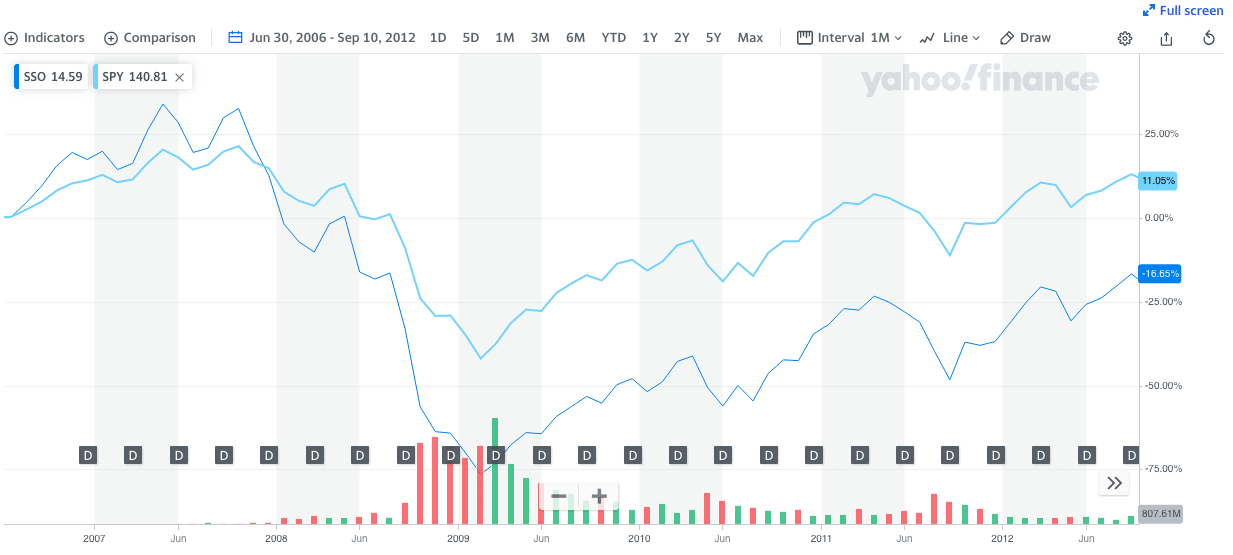
No product on Wall Street draws more criticism than leveraged ETFs. Leverage funds are designed to multiply the performance of indexes, but often do so poorly in the long run. These products were built for traders - not investors. They match the daily return of the underlying index and multiply that.
As such, over time, the returns start to get very skewed. The longer you hold onto these leveraged ETF products, the bigger the disparity in returns you'll see (and it's not in your favor). This is called decay - specifically leveraged ETF decay.
So, why does it happen? Let's check it out.
Example Of Leveraged ETF Decay
The ProShares Ultra S&P500 ETF (SSO) tracks twice the daily return of the S&P500 index every day. If the S&P 500 is up 1%, then SSO should be up 2%. If the S&P 500 is down 2%, then the SSO ETF should be down 4%.
Just how well this tracking works can be seen in a since inception chart comparing the two:

The S&P 500 was up nearly 16%. SSO was down nearly 14%. Why the disparity?
Note: We've been running through a decade-long bull market. As volatility increases in the market, you can expect more examples similar to the one above.
Leveraged ETFs Lose from Compounding
Compounding, the very thing that is supposed to make investors rich in the long run, is what keeps leveraged ETFs from mimicking their indexes in the long haul. Simple mathematics can explain why leveraged ETFs fail to keep pace.
Suppose that the S&P 500 index were to lose 10% on one day, and then gain 10% the next day. (Rarely do big moves like these happen, but it helps illustrate the point – round numbers are easier!)
So, if the S&P 500 starts at the round value of 1400, it would lose 140 points on day one to close at 1260. The next day, it would rise 10%, or 126 points, to close at 1386. The total loss from this two day move is 14 points, or 1%.
Supposing that SSO started out at a value of $60 per share, SSO should lose 20% of its value on the first day. The ETF would close at a value of $48. The next day, it should rise 20% from $48 to $57.60 per share.
At the end of this two day period, the S&P 500 would have lost 1% of its value. By contrast, the SSO ETF would have lost 4% of its value.
Danger of Multiplication
The order in which we do this operation does not matter. Try this out: using the round number of 100, subtract 10%. You arrive at 90. Then add 10%. You get 99. If you reverse the order and add 10% to 100 before subtracting 10%, you get the same result – 99.
The decay happens even faster when you use larger numbers. Subtract 50% from 100 before adding 50%. You’ll get 75.
But let’s get into the real fun. What if you have several days in a row of movement in the same direction? If the S&P 500 index were to move up 2% a day for 10 days straight, its ending value would be 21.8% greater than its starting value.
A 2x leveraged ETF like SSO would move up 4% a day for 10 days straight and thus its ending value would be 48% higher than its starting value. SSO’s return of 48% is greater than two times the 21.8% return of the S&P 500 index.
Volatility Destroys Leveraged ETFs Returns Over Time
The problem is that the market does not move up or down in a straight line. Instead many daily positive and negative moves produce – hopefully! – a positive return in the long run. Exchange-traded funds that track and compound the daily moves, however, always lag their index (and eventually produce negative returns) in the long run.
Triple-leveraged ETFs decay much faster than double leveraged ETFs. For example, Direxion’s TNA fund tracks 3x the daily change in the Russell 2000 index. Since the fund was launched in late 2008 it delivered a lackluster 32% return compared to the Russell 2000 index, which delivered a 66% return.
Despite leverage of 3x, the leveraged fund gained 32% to the index's 66% return.
The end result of this is, you'd have been better off simply keeping your money invested in the underlying index!
How to Juice Returns Safely and Reliably
The only “safe” way to leverage a portfolio is to open a margin account. If you had $50,000 to invest and wanted twice the return of the S&P 500 index, you could buy $100,000 of the S&P 500 index ETF (SPY) on margin. However, this is not a recommended strategy at all - it's incredibly risky.
Since you actually own 2x the amount of the ETF you want to double, you can guarantee that you will get twice the return (minus the cost of interest on your margin account.) You cannot guarantee that a leveraged fund will provide double the return over time. Just realize that you also took on a huge amount of risk - if the ETF drops in price, you will owe more money than your initial investment.
Buying and holding leveraged ETFs is playing with fire. They are designed for day traders... In the long haul, you're certain to get burned.
Final Thoughts
At the end of the day, the best thing to do is simply to invest in a low cost ETF or mutual fund portfolio and enjoy the market returns over time. You can even invest for free and not pay a commission to invest! There are even expense-ratio free mutual funds that you can invest in!

Robert Farrington is America’s Millennial Money Expert® and America’s Student Loan Debt Expert™, and the founder of The College Investor, a personal finance site dedicated to helping millennials escape student loan debt to start investing and building wealth for the future. You can learn more about him on the About Page or on his personal site RobertFarrington.com.
He regularly writes about investing, student loan debt, and general personal finance topics geared toward anyone wanting to earn more, get out of debt, and start building wealth for the future.
He has been quoted in major publications, including the New York Times, Wall Street Journal, Washington Post, ABC, NBC, Today, and more. He is also a regular contributor to Forbes.
Editor: Clint Proctor Reviewed by: Chris Muller
